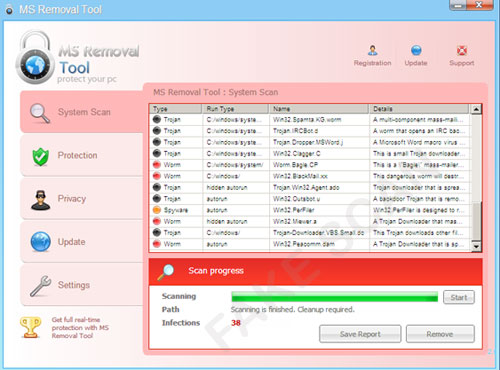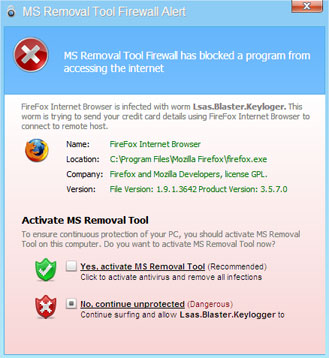TROJ_FAKEAV.WQIA
Windows 2000, Windows XP, Windows Server 2003


Threat Type: Trojan
Destructiveness: No
Encrypted: Yes
In the wild: Yes
OVERVIEW
This Trojan displays fake alerts that warn users of infection. It also displays fake scanning results of the affected system. It then asks for users to purchase it once scanning is completed. If users decide to purchase the rogue product, users are directed to a website asking for sensitive information, such as credit card numbers.
It blocks execution of executable files.
This Trojan arrives on a system as a file dropped by other malware or as a file downloaded unknowingly by users when visiting malicious sites.
It uses icons similar to those of legitimate applications to entice a user to click them.
TECHNICAL DETAILS
501,760 bytes
, EXE
Yes
27 Apr 2011
Arrival Details
This Trojan arrives on a system as a file dropped by other malware or as a file downloaded unknowingly by users when visiting malicious sites.
Installation
This Trojan drops the following non-malicious file:
- %System Root%\Documents and Settings\All Users\Application Data\test
(Note: %System Root% is the root folder, which is usually C:\. It is also where the operating system is located.)
Autostart Technique
This Trojan adds the following registry entries to enable its automatic execution at every system startup:
HKEY_CURRENT_USER\Software\Microsoft\
Windows\CurrentVersion\RunOnce
test = "{malware path and file name}"
Propagation
This Trojan uses icons similar to those of legitimate applications to entice a user to click them.
Rogue Antivirus Routine
This Trojan displays the following fake alerts:
NOTES:
It displays fake alerts that warn users of infection. It also displays fake scanning results of the affected system. It then asks for users to purchase it once scanning is completed. If users decide to purchase the rogue product, users are directed to the following website asking for sensitive information, such as credit card numbers:
- http://{BLOCKED}.{BLOCKED}.209.245/b.php?affid={parameter}&data={parameter}&v=8
It blocks execution of executable files.
SOLUTION
9.200
8.122.08
27 Apr 2011
Step 1
For Windows XP and Windows Server 2003 users, before doing any scans, please make sure you disable System Restore to allow full scanning of your computer.
Step 2
Restart in Safe Mode
Step 3
Search and delete this file
- %System Root%\Documents and Settings\All Users\Application Data\test
Step 4
Delete this registry value
Important: Editing the Windows Registry incorrectly can lead to irreversible system malfunction. Please do this step only if you know how or you can ask assistance from your system administrator. Else, check this Microsoft article first before modifying your computer's registry.
- In HKEY_CURRENT_USER\Software\Microsoft\Windows\CurrentVersion\RunOnce
- test = {malware path and file name}
- test = {malware path and file name}
Step 5
Restart in normal mode and scan your computer with your Trend Micro product for files detected as TROJ_FAKEAV.WQIA. If the detected files have already been cleaned, deleted, or quarantined by your Trend Micro product, no further step is required. You may opt to simply delete the quarantined files. Please check this Knowledge Base page for more information.
Did this description help? Tell us how we did.





